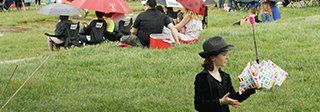

The Thrills of Common Ground
Generally one of two things happens when looking at Mike Sinclair's photographs. If you've never been to the place photographed, his images urge you to go there. Yet even if you know a place well, you wonder how he made this picture, as the images contain stark discoveries that jolt memory. These are the pleasures of great photography, a revision of one's lived experience, and this quality is striking considering the straightforward, almost prosaic nature of Sinclair’s photographs. His are not lusty images and their wonder is subdued, but the lure is palpable. The pictures in this portfolio offer small thrills that usher sweeping adjustments of The Nelson-Atkins Museum of Art, and its home, Kansas City.
These images bring together the Nelson’s transformation of the last half dozen years and Sinclair’s focus on the civic fabric and uplift of the city over the same period. His images crystallize the Nelson’s makeover from a temple of culture into a civic hub that serves as the living room, and backyard, of our city. Here the Nelson is much more than a place to seek a solitary experience of art; it is a land of first dates, yoga on weekends, a quick coffee break, and perhaps the deepest ideal of our community cornerstones — it’s a place where we are comfortable simply to wait.
Sinclair has been called the last chronicler of the American Dream; I think of him rather as one of our last hunters of common ground.
For me, this work connects directly to Kansas City Snapshot, a yearlong project Sinclair and I collaborated on that resulted in the publication Where are you supposed to be?. The project’s goal — to present a snapshot of the city, a sprawling metropolitan area comprised of disparate parts — ballooned before us, at odds with our preconceptions and experience of our home. In mid-summer 2007 we sought to become strangers in our own town and for a solid week we wandered the city. Our attempts to get lost unfurled moments in which the city became larger than our knowledge of it.Through Sinclair’s images, a stack of wood monumentalized the city’s grandest ambitions, even as his image of Satchel Paige Memorial Stadium seemed to boomerang across generations.
Sinclair has since staged an ongoing exploration of civic spaces in Kansas City — its parks, theaters, spaces of democracy, and Main Street. His agenda-free pictures achieve a directionless totality; there is no overarching idea, but their network of relationships careens in precarious orbit. I am struck by his even-handed approach to subjects normally strung along a steep hierarchy. A lesser body of images might overstate the city's divisions, its economic, cultural, and racial fault lines. His pictures however avoid tunnel vision and blithe dismissals. An easy route would be to shoot the city as it is, a monstrously unequal, segregated metropolis, home to oft-misguided policy and a shimmering cultural heritage. Sinclair's strategy however — making images across a vast span of subjects through curiosity and exploration, devoid of hyperbole and critical assumptions — pulls us in and allows us to get lost in the fraught relations of the city, not bound up in the politics of the image.
Sinclair shoots from our perspective, his pictures earned by a willingness to stick around, and an uncanny ability to be at-ease in any place. In these images, we can see Sinclair waiting it out, withholding judgment and embedding himself as a humble participant within places he isn't supposed to be, yet that welcome all of us.
Again and again, in Kansas City or elsewhere, I run into one of Sinclair's pictures — places that I imagine embody his vision — such that I look forward to these moments of arrival. I find myself lost, the world suddenly larger than before. His pictures come about as moments of discovery, elegant and thrilling proof of our common ground.
Hesse McGraw
Vice President for Exhibitions and Public Programs, San Francisco Art Institute